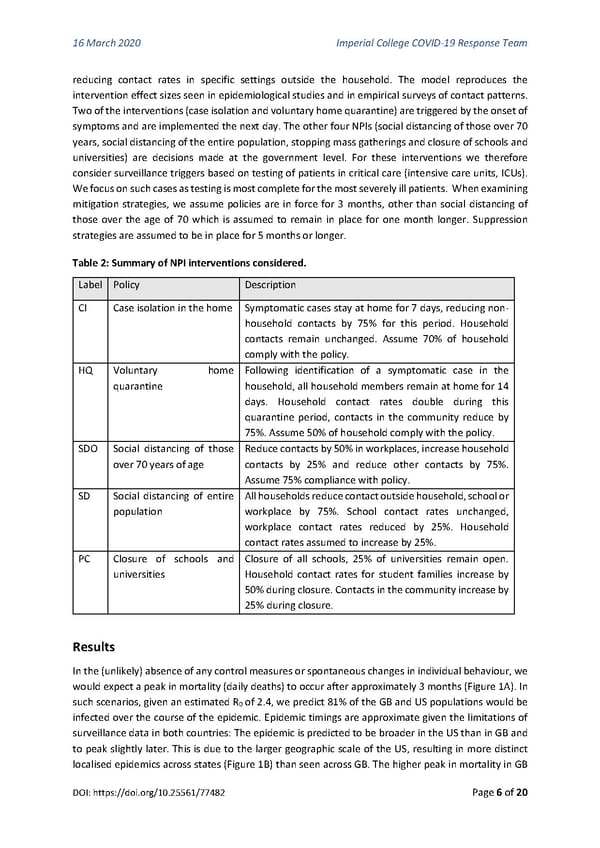16 March 2020 Imperial College COVID-19 Response Team reducing contact rates in specific settings outside the household. The model reproduces the intervention effect sizes seen in epidemiological studies and in empirical surveys of contact patterns. Two of the interventions (case isolation and voluntary home quarantine) are triggered by the onset of symptoms and are implemented the next day. The other four NPIs (social distancing of those over 70 years, social distancing of the entire population, stopping mass gatherings and closure of schools and universities) are decisions made at the government level. For these interventions we therefore consider surveillance triggers based on testing of patients in critical care (intensive care units, ICUs). We focus on such cases as testing is most complete for the most severely ill patients. When examining mitigation strategies, we assume policies are in force for 3 months, other than social distancing of those over the age of 70 which is assumed to remain in place for one month longer. Suppression strategies are assumed to be in place for 5 months or longer. Table 2: Summary of NPI interventions considered. Label Policy Description CI Case isolation in the home Symptomatic cases stay at home for 7 days, reducing non- household contacts by 75% for this period. Household contacts remain unchanged. Assume 70% of household comply with the policy. HQ Voluntary home Following identification of a symptomatic case in the quarantine household, all household members remain at home for 14 days. Household contact rates double during this quarantine period, contacts in the community reduce by 75%. Assume 50% of household comply with the policy. SDO Social distancing of those Reduce contacts by 50% in workplaces, increase household over 70 years of age contacts by 25% and reduce other contacts by 75%. Assume 75% compliance with policy. SD Social distancing of entire All households reduce contact outside household, school or population workplace by 75%. School contact rates unchanged, workplace contact rates reduced by 25%. Household contact rates assumed to increase by 25%. PC Closure of schools and Closure of all schools, 25% of universities remain open. universities Household contact rates for student families increase by 50% during closure. Contacts in the community increase by 25% during closure. Results In the (unlikely) absence of any control measures or spontaneous changes in individual behaviour, we would expect a peak in mortality (daily deaths) to occur after approximately 3 months (Figure 1A). In such scenarios, given an estimated R of 2.4, we predict 81% of the GB and US populations would be 0 infected over the course of the epidemic. Epidemic timings are approximate given the limitations of surveillance data in both countries: The epidemic is predicted to be broader in the US than in GB and to peak slightly later. This is due to the larger geographic scale of the US, resulting in more distinct localised epidemics across states (Figure 1B) than seen across GB. The higher peak in mortality in GB DOI: https://doi.org/10.25561/77482 Page 6 of 20
 Non-Pharmaceutical Interventions to reduce COVID-19 mortality and healthcare demand Page 5 Page 7
Non-Pharmaceutical Interventions to reduce COVID-19 mortality and healthcare demand Page 5 Page 7